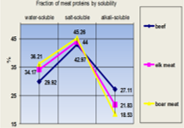Abstract
The article presents the research of the protein composition of meat of wild animals (elk and wild boar) and domestic animals (beef), by their isolation and separation methods due to their different solubility in different solutions, conducted in the laboratory of Biological Safety of Food Systems of the Department of Meat and Dairy Products Technology of Mari State University. The total proteins or protein fractions were extracted from a homogenized chilled meat sample. Then, the colorless proteins in the extract were transferred to the colored product, adding a biuret reagent, and studied the D optical density of separate protein fractions on the photoelectric concentration colorimeter PCC-2, determining the absorption of emitting at a wavelength of 540 nm. The protein content of the samples was expressed in the mass fraction of the protein fraction in the sample in g/ 100g of meat and in percentages. The calculation was based on the previously found linear calibration dependence of the optical density on the concentration of the standard protein. Differentiation of proteins by solubility (water-soluble, soluble in salts, alkaline-soluble, albumins, globulins), fractional composition (sarcoplasmic, myofibrillar and connective tissue), peculiarities of the biochemical structure (high-grade and inferior). Protein extracts of muscle tissue of wild and domestic animals obtained during sequential extraction are used to quantify the protein content of a certain fraction, as well as to research the properties of proteins.
Full text article
Authors

This work is licensed under a Creative Commons Attribution-NonCommercial-NoDerivatives 4.0 International License.

